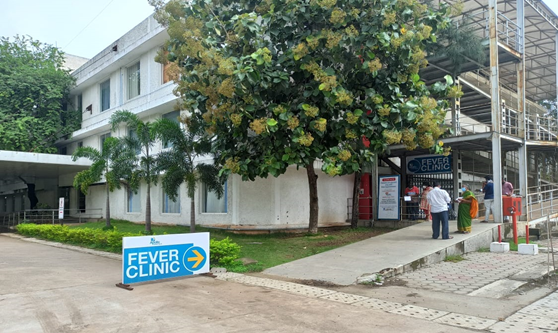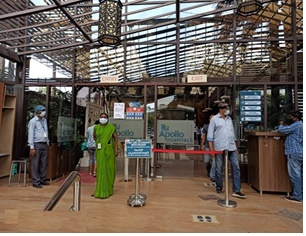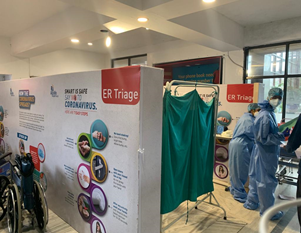Introduction:
We would like to share our experiences in treating critically ill COVID-19 patients in our COVID unit. With complete infrastructure and world-class infection control facilities, Apollo Hospitals was the first corporate hospital in Hyderabad to have come forward to take care of COVID-19 patients. The management team was very pro-active and co-operative in providing the resources and the logistic support. We initiated the project with a preliminary plan and policies in place. The initial parts of our journey was definitely tough, but over time we moved ahead positively as the information on COVID-19 unfolded worldwide.
Establishing a separate COVID-19 Unit
Our experience in managing patients with COVID-19 started way back in March 2020. During that time we converted our rehabilitation center into a dedicated COVID-19-unit, which is located 250 meters away from the main hospital. It could minimize the risk of in-hospital transmission by virtue of location in a separate building. Patients who presented to the main hospital with suspected features of COVID-19 like fever, cough and cold were (and are still) segregated and triaged according to our protocol and sent to the fever clinic, which is on the ground floor of the COVID-19 unit. We were and are still reporting every COVID-19 positive patient to the regional coordinating center as per state government and central government guidelines.
In the Fever Clinic the Infectious Disease Specialist evaluates the case and shifts them to the ward or home depending on the clinical condition. In the COVID-19 unit the first floor was dedicated to mildly symptomatic positive coronavirus infected patients who require minimal oxygen. The entire 2nd floor was designed as a COVID-19 ICU, where patients with moderate and severe symptoms, who are critically ill and who require mechanical ventilation can be treated.
COVID Unit

COVID-19 – Triage & Pathway
COVID-19 triage plan was placed at each patient entry point. Patients who are sick and are suspected with COVID-19 infection, in the emergency room, will receive care in a dedicated triage area and then shifted to the COVID-19-ICU if they test positive. If any of the suspected patients become negative in COVID-19 unit, they are shifted back to the main hospital. If the patient report is negative for COVID-19, but still clinically suspicious, a second sample to test for COVID-19 is sent. In this manner meticulous adherence to strict protocols that were designed right from the beginning of March are being followed to date. The protocols are updated frequently as new knowledge is discovered
Pre Triage Entrance

Triage area

Man power – Mobilization and Training
A dedicated work force was created for taking care of the COVID-19 unit, which included the medical and supporting staff under the leadership of critical care team. Separate duty roster with quarantine facility was created for it. Periodic counselling, symptom tracking and medication prophylaxis was performed by independent stakeholders. All medical staff are aware of their responsibilities clearly and everyone was given proper training about safety measures (like donning and doffing of PPE) while providing care to COVID positive patients. Staff was given adequate rest while performing duties in the COVID-19 ward or ICU. In our hospital staffing was staggered and planned with extra care providers in reserve, because of the high possibility of staff becoming affected with the disease.
Tender Loving Care for Patients & their Families
At Apollo, we believe in providing care with empathy. Thanks to the over information on COVID-19 in the social media, it a created havoc and spread unwanted fears among the patients and their families. The family members of the patients are counselled through video-conference about the patients’ condition and they could see and communicate with the patient too. Panic attacks among patients and their family members, owing to fear of death due to COVID-19 was relieved by providing assurance and counselling with the help of psychiatrists, psychologists, medical social workers and spiritual leaders.
Role of e-ICU
In addition to the regular care and monitoring, all patients in the COVID-19 unit were remotely monitored through the Remote Intensive Care Division of the Department of Critical Care Medicine. Over 100 beds were linked by camera. Care required, including vital signs observation was done 24/7 through these cameras.
COVID-19 Treatment Trend (Pre-Lockdown to Present)
In the beginning, patients with mild disease in the ward are kept under observation with vitamin C and zinc supplements. Those with moderate and severe disease in the ICU are treated with anticoagulants, hydroxychloroquine (HCQ) in some selected cases, and steroids. Ivermectin is being used for patients above 50 years, in concurrence with steroids, for prevention of worm infestation, not as a definitive COVID-19 therapy. Doxycycline was also tried along with main treatment as an adjunct and treat other forms of pneumonia. Patients were put on oral steroids in tapering doses and oral anticoagulants in recovery phase for 2-4 weeks depending on severity of the disease. Patients with established clots have been recommended 3 months of anticoagulation.
Patients who required oxygen support, were provided oxygen through either nasal prongs, face mask or high concentration mask as per the requirement. Those who were unable to improve oxygenation were supported with high frequency nasal cannula (HFNC) or non-invasive ventilation (NIV). In our experience patients with hypoxemic respiratory failure, may show improvement in oxygenation with HFNC, but work of breathing is not decreasing. But the patients who are on NIV ventilation are more comfortable, their oxygenation was reasonably stable and lower requirement for intubation and mechanical ventilation. Patients whose saturation was below 90% even with HFNC or NIV and whose ABG were declining were electively intubated and put on ventilator support.
Patients in the ICU had measurement of inflammatory markers and labs including Complete Blood Picture, CRP, hs-Troponin I, LDH, D-DIMER, Renal Function Panel, Liver Function Tests, IL-6 and ferritin. Most of COVID-19 positive patients who are symptomatic in the hospital had CT scan of the chest for assessment of severity (through CO-RADS score and CT severity index).
Over the last few months all drugs have become available and at present patients are given RED therapy which includes Remdesivir, Enoxaparin sodium and Dexamethasone or Methylprednisolone therapy for moderate to severe disease. Patients who are not responding to RED therapy were tried with tocilizumab or convalescent plasma therapy either singly or as a combination with the appropriate indication and informed consent.
In our experience patients who are presenting early to hospital, with warning signs like mild breathlessness and oxygen saturation of less than or equal to 94% were able to recover completely. Patients with multiple health problems, older age, immunocompromised or those who required mechanical ventilation had a lower possibility of survival as has been seen globally.
Unlike pre-lockdown phase, currently all treatment options are streamlined and in a disciplined manner. Some patients, neither worsen nor improve, but stuck on either HFNC or NIV for weeks together, their outcome is poor. Awake proning helps patients improve oxygenation and early shift out from the ICU, but patients who are on ventilator there may be an improvement in oxygenation but unclear mortality reduction.
Post-COVID-19 sequelae
Patients who recovered from disease and were discharged from hospital may still have residual weakness, tiredness and mild breathlessness for 1 or 2 months in recovery period (Post-COVID-19 sequelae). It has been observed that repeat CT scan of the chest showed fibrosis of the lungs. Patients with COVID-19 frequently have myocarditis, pericardial effusions, and while on treatment and also during recovery. Death in majority of the patients is due to thrombotic complications or ARDS.
Once a COVID-19 patient recovers — is it end forever?
Some patients, who recovered and discharged happily, got re-admitted with recurrence of symptoms. Few of those cases were due to secondary cytokine storm. An example is a patient whose IL-6 levels at the time of discharge was 85 pg/dl, who became symptomatic 7 days after discharge and again admitted with IL-6 of 2570 pg/dl. That patient during initial admission was treated with RED therapy. In second admission he required NIV, tocilizumab, convalescent plasma therapy and finally recovered. Although IL-6 levels have been postulated to not always correlate with extent of ARDS each patient needs individual evaluation of risks and benefits.
A Unique & Challenging Experience in Treating a COVID-19 pregnant woman
A pregnant patient, near to term, got admitted in the emergency department with COVID-19 positive condition. She became serious and was placed on ventilator. She needed emergency caesarean surgery. Post-surgery, the new born baby was in cardiac arrest, but was fortunately resuscitated through a heroic team effort. The mother was shifted to the ICU on the ventilator. After 10 days of mechanical ventilation with RED therapy, tocilizumab and convalescent plasma therapy the patient was weaned from the ventilator, recovered and discharged. At the time of discharge both mother and baby were doing well.
Details of the case can be read here:
http://www.rspnetwork.in/2020/08/apollo-doctors-perform-miracle-by.html
ECMO/ECCO2R – the game changer
In our experience the condition of 8 to 10% of patients deteriorated despite of optimal medical and ventilator support. For such patients we provided extracorporeal therapy. ECMO (Extracorporeal Membrane Oxygenation) as our main modality. We selected ECCO2R as the rescue therapy for a patient who was unfit for ECMO. Our experience was encouraging as it is easier, cheaper and less invasive.
Talent wins games, but teamwork wins championships!
As a team, the Department of Critical Care Medicine is an integral and essential part of the hospital. Our various experts and specialists have been spending countless hours in managing COVID-19 patients. Many have themselves been infected but returned to work after recovery. The Coronavirus pandemic crisis and the challenges associated with its treatment has also shown us that as healthcare providers we must always focus on empathy, compassion and exceptional evidence-based care. We are proud to be a part of this amazing group.
Written By:-
Dr. Nagaraju Gorla
MBBS, MD, Senior Consultant Critical Care,
Clinical Supervisor for EMFP Programme, RCEM-UK, FID-ROYAL LIVERPOOLACAMEDY (UK)
Apollo Hospitals, Jubilee Hills, Hyderabad
Dr. Niranjan Panigrahi
MBBS, MD, FNB Critical Care, EDIC
Consultant Critical Care
Faculty in Academic Team
Apollo Hospitals, Jubilee Hills, Hyderabad


















